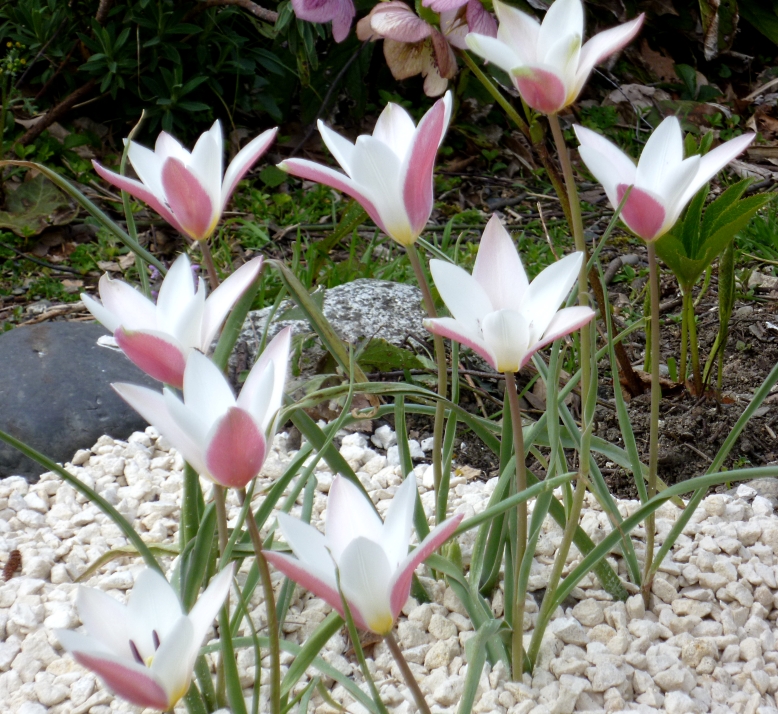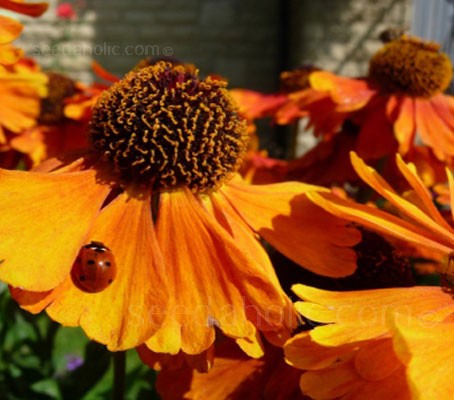
How does this little tulip do it? We are talking stems the width of shoelaces, and the flowers seem so delicate, looking rather ghostly in the greyness and wet of today. In fact, their light meter is definitely stuck at ‘sunny’. I am astonished by the casually butch approach it is taking to our latest bout of winter. We are back to freezing temperatures, wind and rain, even thunder, and once again, any sensible plant has just stopped in its tracks.

Indoors, I have been laughing out loud at Anna Pavord’s 2010 book, ‘The Curious Gardener’. Her deft wit and sense of humour pervades this selection of articles she wrote when gardening correspondent for ‘The Independent’. I really did laugh at her account of Pavord family Christmases- and I love her self-effacing acceptance of gardening bloomers and disasters. Unlike some, whose books can simply load you up with guilt-inducing instruction, she lightens all loads with her humour and likes and dislikes.
When the weather has given up annoying me for short periods, I have been out planting. I have to, as my experimental growing perennials from seed phase has produced about a hundred small pots. All of these have either been sitting on gravel through all the weather we have had, or some lucky ones got planted out in a spare patch to be dug up in the Spring.

Included in that number were some purchases last Autumn that I split and re-potted, so all in all, there is no excuse for not planting up generously. I have been really struck by how bombproof these small plants have been. I reckon that the death rate has been only 1-2%- which is brilliant. The baby Echinacea pupureas were almost washed away in the rains of January and February, but all are putting on good growth although I need to top them up with a bit more compost.

So, I am having a dense planting push. I am ignoring conventional planting distances and going for less than half the normal recommendations. I have one area that is entirely perennials with some added structural plants- and this area, now approaching its third birthday, is looking very promising, with lots of self-seeding. All I am doing is taking out dandelions and other major pests- otherwise, I am leaving it alone.

In other parts of the garden, I am using this chance to really beef up the planting. Mulching is a tricky proposition for me. It risks flattening self-seeding, which is what I am after, and so I am trying out a slightly different approach. Having read a short article about Thomas Rainer, an American landscape architect who is a big mover in the sustainable planting world, I then bought his book, written with Claudia West, ‘Planting in a post-Wild World’. This is a scholarly tome, which carefully explains the building of resilient plant communities, but at the heart of it are the following principles:
- Amending the soil- don’t
- Double digging- don’t
- Soil testing- do
- Mulching- don’t
- Planting cover crops- do
- Buying a lot of plants- do
- Curbside planting- do
- Experimenting and having fun- do
By all means read the book- it is very inspiring, but to get the gist, the Gardenista website article kickstarts all you need to know. I am not a regular Gardenista reader, too much designery clap-trap for me, but just sometimes, it is spot-on.
So, with my small and brilliantly tough plants, I am setting out to offer them co-habitation in the hope that they will make me some resilient plant communities. And where it is tricky to that fully, I am doing something different again.
My driest, hottest parts are actually pretty much jam-packed with plants- but even so, in our wet Springs, I get masses of passing-through weed activity. By that I mean, naturally occurring early season weeds, which actually mostly get burnt off or dried out by the height of summer. So, this year, I am not going to charge about pulling them out, I am going to leave them be. This is on the grounds that they have a role in protecting the durable plants through the winter and spring, and then, by and large, they die off. So, as long as the balance between them, and the permanent plants stays in place- they are actually preventing the dessication and erosion of the soil by being there.
Thinking over- I am dying to get out there again!
This sounds really exciting and interesting. I love Anna Pavord too.
LikeLiked by 2 people
Thank you…will my nerve hold? More rain and those early season weeds might get too bolshie…
LikeLiked by 1 person
6 and 7 DON’T I miss buying plants, but I have no more room. That is the trouble for those of us who propagate our own! I can’t do curbside planting because I don’t have a curb. I will compensate.
LikeLiked by 2 people
Oh no! No more room! I may be approaching that point, but I have to admit to a ‘chuck it out’ policy to make space…
LikeLiked by 1 person
Your plans sound wonderful, but leave some dandelions because their first flowers will feed the bees after the snow ! 🐝🐝🐝🐝
LikeLiked by 1 person
Well, the grass is chockablock with dandelions….and daisies..I love both!
LikeLiked by 2 people